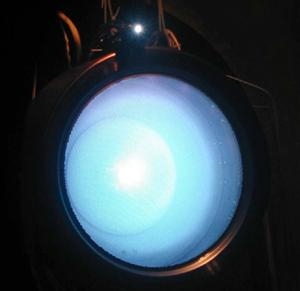Mon, Jul 01, 2013
Advanced Ion Engine Has Run Continuously for 48,000 Hours
A NASA advanced ion propulsion engine has successfully operated for more than 48,000 hours, or 5 and a half years, making it the longest test duration of any type of space propulsion system demonstration project ever. The thruster was developed under NASA's Evolutionary Xenon Thruster (NEXT) Project at NASA's Glenn Research Center in Cleveland. Glenn manufactured the test engine's core ionization chamber. Aerojet Rocketdyne of Sacramento, CA, designed and built the ion acceleration assembly.

The 7-kilowatt class thruster could be used in a wide range of science missions, including deep space missions identified in NASA's Planetary Science Decadal Survey. "The NEXT thruster operated for more than 48,000 hours," said Michael J. Patterson, principal investigator for NEXT at Glenn. "We will voluntarily terminate this test at the end of this month, with the thruster fully operational. Life and performance have exceeded the requirements for any anticipated science mission."
The NEXT engine is a type of solar electric propulsion in which thruster systems use the electricity generated by the spacecraft's solar panel to accelerate the xenon propellant to speeds of up to 90,000 mph. This provides a dramatic improvement in performance compared to conventional chemical rocket engines. During the endurance test performed in a high vacuum test chamber at Glenn, the engine consumed about 1,918 pounds of xenon propellant, providing an amount of total impulse that would take more than 22,000 pounds of conventional rocket propellant for comparable applications.
"Aerojet Rocketdyne fully supports NASA's vision to develop high power solar electric propulsion for future exploration," said Julie Van Kleeck, Aerojet Rocketdyne's vice president for space advanced programs. "NASA-developed next generation high power solar electric propulsion systems will enhance our nation's ability to perform future science and human exploration missions."
(NEXT ion thruster image provided by NASA.)
More News
He Attempted To Restart The Engine Three Times. On The Third Restart Attempt, He Noticed That Flames Were Coming Out From The Right Wing Near The Fuel Cap Analysis: The pilot repor>[...]
Make Sure You NEVER Miss A New Story From Aero-News Network Do you ever feel like you never see posts from a certain person or page on Facebook or Instagram? Here’s how you c>[...]
From 2009 (YouTube Edition): Leading Air Show Performers Give Their Best Advice for Newcomers On December 6th through December 9th, the Paris Las Vegas Hotel hosted over 1,500 air >[...]
Aero Linx: NASA ASRS ASRS captures confidential reports, analyzes the resulting aviation safety data, and disseminates vital information to the aviation community. The ASRS is an i>[...]
“For our inaugural Pylon Racing Seminar in Roswell, we were thrilled to certify 60 pilots across our six closed-course pylon race classes. Not only did this year’s PRS >[...]
 NTSB Final Report: Rutan Long-EZ
NTSB Final Report: Rutan Long-EZ ANN FAQ: Turn On Post Notifications
ANN FAQ: Turn On Post Notifications Classic Aero-TV: ICAS Perspectives - Advice for New Air Show Performers
Classic Aero-TV: ICAS Perspectives - Advice for New Air Show Performers ANN's Daily Aero-Linx (06.28.25)
ANN's Daily Aero-Linx (06.28.25) Aero-News: Quote of the Day (06.28.25)
Aero-News: Quote of the Day (06.28.25)



